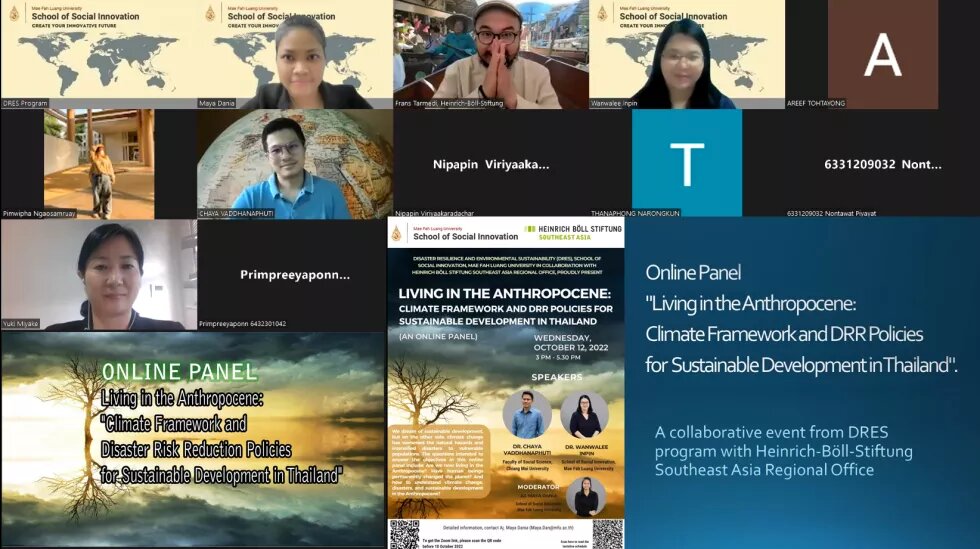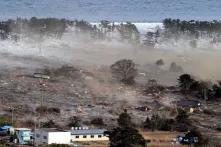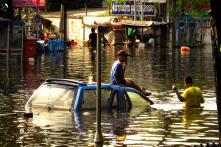
A note from an online panel entitled “Living in the Anthropocene: Climate Framework and DRR Policies for Sustainable Development in Thailand” on 12 October 2022, co-organized by Disaster Resilience and Environmental Sustainability (DRES), Mae Fah Luang University and Heinrich-Böll-Stiftung Southeast Asia regional office.

"I've seen many humanitarian disasters in the world, but I have never seen climate carnage on this scale. I have simply no words to describe what I have seen today". Quoting the United Nations Secretary-General, António Guterres (2022), as he toured around parts of Pakistan severely hit by floods. After arriving in Pakistan, Guterres mourned the destruction of disasters from the lack of attention the industrialized nations to climate change as insanity and collective suicide. The quote by the UN's Secretary-General reflects the current deadly flooding in Pakistan, also by the current report by the UNDP (2020) has clearly stated that we are now experiencing a climate crisis with biodiversity collapse, ocean acidification, and other changes in the planet that the list is long and growing longer. As the UNDP reported, so much so that many scientists believe that for the first time, instead of the planet shaping humans, humans are knowingly shaping the planet.
Humanity has achieved incredible progress, but we have taken the Earth for granted, destabilizing the systems we rely on for survival. This is the Anthropocene – the Age of Humans - a new geologic epoch. The word Anthropocene comes from the Greek terms for 'Anthropos' (human) and 'cene' (new). Together, the word means the new era or the new time during which humans have had a great impact on our planet. The Anthropocene describes the most recent period in Earth's history when human activity significantly impacted the planet's climate and ecosystems. In the Anthropocene, humans have become the most influential species on the planet, causing significant global warming and other changes to land, environment, water, organisms, and the atmosphere. Evidence of the human impacts can be seen from the fertilizer or pesticides of intensive farming, the carbon from burning fossil fuels, the plastic in the deep ocean, the radioactive material from the nuclear explosion, and the extinction of many species throughout decades.
Global countries dream of sustainable development, but on the other side, climate change has worsened the natural hazards and intensified disasters to vulnerable populations. In making the relevant dream of sustainable development in Thailand in the age of Anthropocene, the questions intended to answer the objectives in this online panel include: Are we now living in the Anthropocene? Have human beings permanently changed the planet? And how to understand climate change, disasters, and sustainable development in the Anthropocene? Quo Vadis DRR and climate policy in Thailand?
Vulnerability and Justice Lenses are Missing from the Current Climate Framework in Thailand
Dr. Chaya Vaddhanaphuti from Chiang Mai University opens the panel by addressing whether climate change is unnatural or human-induced, what anthropogenic activities affect climate change in the Anthropocene, and how Thailand (or regional countries) has prepared a climate framework to target sustainable development. In the age of the Anthropocene, there are several challenges that Thailand needs to pay attention to in terms of so-called anthropogenic climate change. As such, issues of energy, waste management, and carbon dependency. Several actions have been taken from the national and intergovernmental policies to implementation, including the establishment of the Department of Climate change, green investment and financing, carbon market, carbon forest, climate change act, bio-circular green economy and SDGs, with each province to have their own tailored climate policy, but some things are missing.
At the international level, Thailand is Party to the Paris Agreement. In terms of international cooperation, Thai-German intergovernmental cooperation under the Office of Natural Resource and Environmental Policy and Planning (ONEP) and Deutsche Gesellschaft für Internationale Zusammenarbeit (GIZ) laid a standpoint for Thailand Climate Change Master Plan 2012 – 2050. The cooperation has encouraged better communication and education about climate change mitigation and adaptation, enhanced sustainability, helped the country pursue a low-carbon society, and implemented national policy at sub-provincial levels through green climate fund, waste management, agriculture, and energy, water, and policy. In 2022, Bangkok hosted the Thailand Climate Action Conference (TCSC) to promote efforts to achieve carbon neutrality in the country by 2050 and reduce greenhouse gas emissions to zero with the theme "Future of Thailand and the World: Opportunities and Responsibilities" as a tangible action to demonstrate to the 27th UNCC conference (COP27) in Egypt.
Nevertheless, despite the climate mitigation actions taken, the country still relies heavily on fossil fuels with clean coal propaganda might still be problematic to be implemented while 80% of the country's energy is derived from fossil fuels. Moreover, problematic pitfalls of agrarian livelihoods versus forest-risk commodities and land-grabbing issues in the Mekong region are still critical at the local level. There have been practices of unsustainable consumption and production ongoing with increasing demographic pressures, as well as persistent unsustainable use and management of land (change in land use), ocean, and water that the issues are not mentioned in the Climate Change Act. Present development challenges in the country are still missing with adaptation plans that remain sectorial, unprepared for compounded and complex multiple climatic and non-climatic risks. Thus, compared to a capital-driven and business-oriented mitigation plan, IPCC recommends adaptation solutions that are effective, feasible, and conform to principles of justice. Maybe this is the time for the country to put more voices on the climate justice lens that focus on the subaltern, the population directly dependent on the ecosystem to meet their basic needs, through the justice lens to see vulnerability at different spatial levels that have been exacerbated by inequity and marginalization linked to gender, ethnicity, low income, or combinations. In the age of the Anthropocene, it is time to rethink the politics of knowledge in understanding the climate adaptation process and actions by series of small actions in a more-than-climate policy that aim to reduce inequality and injustice for the vulnerable populations in the development plan in the country.
Seeing Vulnerability through the Lens of Disaster Education in Thailand
Dr. Wanwalee Inpin from Mae Fah Luang further discusses the impacts of climate change, particularly on vulnerable populations in Thailand and if there are best practices of DRR policies at the local level to give hope for a sustainable future despite the increasing threat of frequency and intensity of disasters in the age of Anthropocene. The flood might be meteorological in Thailand, caused by low rainfall and seasonal climate variability. However, it could also be hydrological with the sudden and extreme volume of water that flows rapidly, mostly characterized by abnormal heavy precipitation and quick inception exposed to a vulnerable population, particularly people who rely upon their livelihood from farming activities. The economic, social, and environmental costs and losses associated with the flood in Thailand are also significant to the agricultural environment. The most tangible examples are decreasing food production because of affected crop field areas and reducing rural farmers' income from harvest failure.
There are factors influencing the vulnerability of Thai farmers, in this case, in Chiang Rai Province, such as farmers' average per capita income is lower than the national average and almost 10% of Thai farmers facing income shortfalls. However, the amount of compensation provided by the government policy is inadequate compared to the number of damages and losses the farmers have. The vulnerability also emerges because the local government lacks financial support to enhance the preparedness program. As a result, the capacity of people to deal with flooding is inadequate, with a lack of knowledge of coping with disaster, especially in preparing the farmland for disaster. As a result, it affects the recovery process without preparation, awareness, and prevention skills. While the national government must be in charge of disaster management as a whole, at the local level, not only does the local government need to be taken into consideration, but also people in the communities, especially those who have been affected by disasters, both natural and man-made, and this can be done through the implementation of Disaster Education alongside with Disaster Risk Management. Thus, government at all levels can strengthen their responses and collaboration to help people develop resilience in the face of catastrophes.
From the case study of flooding in Chiang Rai Province in Northern Thailand, the local authorities act as the leading provider of various community services and as the implementing agency for most of the DRR activities, such as promoting local development planning, comprehensive school safety, disaster-resilient cities and villages through community-based DRR at the local level. However, it is evident that in governing DRR activities in Chiang Rai, the government at the local level still applied the traditional disaster management that refers to bureaucratic command and control during the emergency, especially in managing disaster occupational recovery. Disaster education attempts to increase protective actions by people by presenting information about the hazard and the risk it poses. Because individuals must study and comprehend the catastrophe before they can grow their awareness of what they have learned, 'disaster education' is another crucial component to help us deal with being affected by disasters. People will be more able to respond appropriately to the situation, defend themselves, and lessen their vulnerability.
Finally, the panel concludes that localizing the environmental issue in the Anthropocene is another crucial prerequisite for a successful sustainable action―and for returning to a path capable of achieving resilience and sustainability. The megatrends of rapid urbanization, climate response, population growth, and energy use are just some challenges in the Anthropocene age. Therefore, our concept of sustainable development will need to include climate security, addressing inequalities, upholding human rights and good governance through understanding the linkages between climate crisis, disaster risk education, and the Anthropocene.
__
Maya Dania is a lecturer in International Development and a researcher in DRES (Disaster Resilience and Environmental Sustainability) at the School of Social Innovation at Mae Fah Luang University in Chiang Rai, Thailand. She is also doing her Ph.D. in the Faculty of Social Science at Chiang Mai University, researching predicaments and the Chinese BRI projects in the Mekong River wetlands' livelihood.
The views expressed in this article are not necessarily those of Heinrich Böll Stiftung




